Attached files
| file | filename |
|---|---|
| 8-K - 8-K - Independence Contract Drilling, Inc. | a8-khowardweil032017form.htm |
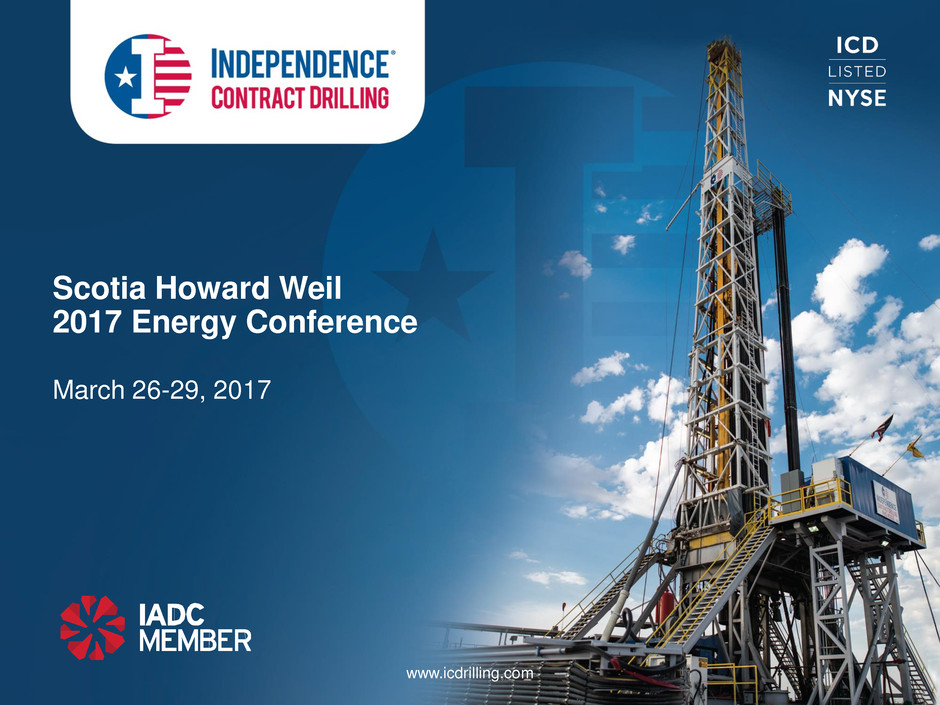
Scotia Howard Weil
2017 Energy Conference
March 26-29, 2017
www.icdrilling.com

Preliminary Matters
Various statements contained in this presentation, including those that express a belief, expectation or intention, as well as those that are not statements of historical fact, are forward-looking statements. These forward-
looking statements may include projections and estimates concerning the timing and success of specific projects and our future revenues, income and capital spending. Our forward-looking statements are generally
accompanied by words such as “estimate,” “project,” “predict,” “believe,” “expect,” “anticipate,” “potential,” “plan,” “goal,” “will” or other words that convey the uncertainty of future events or outcomes. The
forward-looking statements in this presentation speak only as of the date of this presentation; we disclaim any obligation to update these statements unless required by law, and we caution you not to rely on them
unduly. We have based these forward-looking statements on our current expectations and assumptions about future events. While our management considers these expectations and assumptions to be reasonable,
they are inherently subject to significant business, economic, competitive, regulatory and other risks, contingencies and uncertainties, most of which are difficult to predict and many of which are beyond our control.
These and other important factors, including those discussed under “Risk Factors” and “Management’s Discussion and Analysis of Financial Condition and Results of Operations” included in the Company’s filings
with the Securities and Exchange Commission, including the Company’s Annual Report on Form 10-K, may cause our actual results, performance or achievements to differ materially from any future results,
performance or achievements expressed or implied by these forward-looking statements. These risks, contingencies and uncertainties include, but are not limited to, the following:
• our inability to implement our business and growth strategy;
• a sustained decrease in domestic spending by the oil and natural gas exploration and production industry;
• decline in or substantial volatility of crude oil and natural gas commodity prices;
• fluctuation of our operating results and volatility of our industry;
• inability to maintain or increase pricing on our contract drilling services;
• delays in construction or deliveries of reactivated, upgraded, converted or new-build land drilling rigs;
• the loss of material customers, financial distress or management changes of potential customers or failure to obtain contract renewals and additional customer contracts for our drilling services;
• an increase in interest rates and deterioration in the credit markets;
• our inability to raise sufficient funds through debt financing and equity issuances needed to fund future rig construction projects;
• additional leverage associated with borrowings to fund rig conversions and additional newbuild rigs;
• our inability to comply with the financial and other covenants in debt agreements that we may enter into as a result of reduced revenues and financial performance;
• a substantial reduction in borrowing base under our revolving credit facility as a result of a decline in the appraised value of our drilling rigs or substantial reduction in our rig utilization;
• overcapacity and competition in our industry; unanticipated costs, delays and other difficulties in executing our long-term growth strategy;
• the loss of key management personnel;
• new technology that may cause our drilling methods or equipment to become less competitive;
• labor costs or shortages of skilled workers;
• the loss of or interruption in operations of one or more key vendors;
• the effect of operating hazards and severe weather on our rigs, facilities, business, operations and financial results, and limitations on our insurance coverage;
• increased regulation of drilling in unconventional formations;
• the incurrence of significant costs and liabilities in the future resulting from our failure to comply with new or existing environmental regulations or an accidental release of hazardous substances into the environment;
• the potential failure by us to establish and maintain effective internal control over financial reporting;
• lack of operating history as a contract drilling company; and
• uncertainties associated with any registration statement, including financial statements, we may be required to file with the SEC.
All forward-looking statements are necessarily only estimates of future results, and there can be no assurance that actual results will not differ materially from expectations, and, therefore, you are cautioned not to place
undue reliance on such statements. Any forward-looking statements are qualified in their entirety by reference to the factors discussed throughout this presentation and in the Company’s filings with the Securities and
Exchange Commission, including the Company’s Annual Report on Form 10-K. Further, any forward-looking statement speaks only as of the date of this presentation, and we undertake no obligation to update any
forward-looking statement to reflect events or circumstances after the date on which the statement is made or to reflect the occurrence of unanticipated events.
Adjusted Net Loss, EBITDA and adjusted EBITDA are supplemental non-GAAP financial measures that are used by management and external users of the Company’s financial statements, such as industry analysts,
investors, lenders and rating agencies. The Company’s management believes adjusted Net Loss, EBITDA and adjusted EBITDA are useful because such measures allow the Company and its stockholders to more
effectively evaluate its operating performance and compare the results of its operations from period to period and against its peers without regard to its financing methods or capital structure. See non-GAAP financial
measures at the end of this presentation for a full reconciliation of Net Loss to adjusted Net Loss, EBITDA and adjusted EBITDA.
2
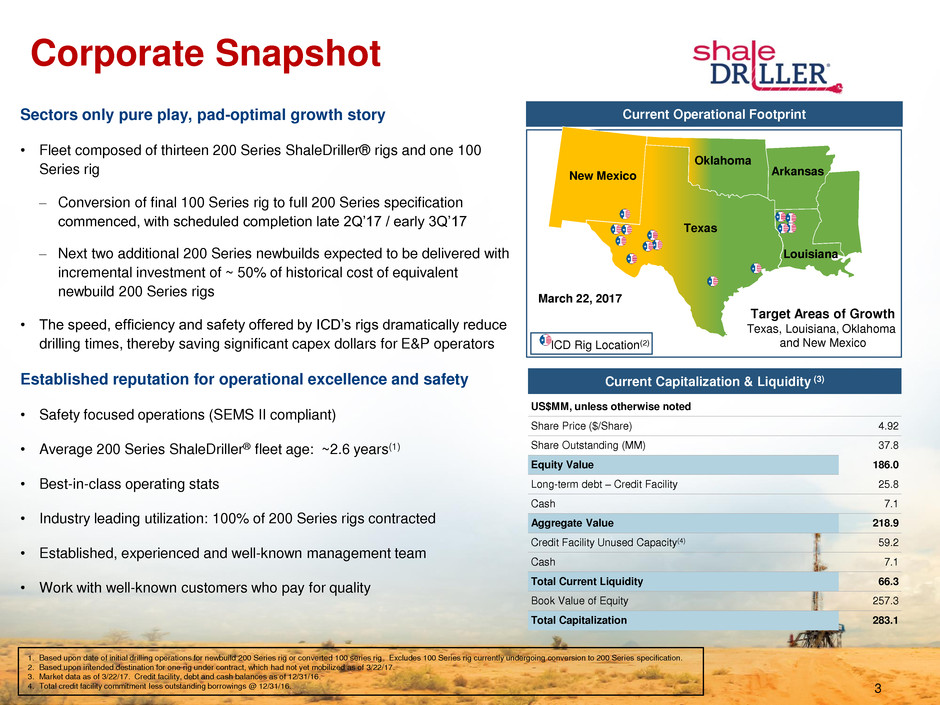
ICD Rig Location(2)
1. Based upon date of initial drilling operations for newbuild 200 Series rig or converted 100 series rig. Excludes 100 Series rig currently undergoing conversion to 200 Series specification.
2. Based upon intended destination for one rig under contract, which had not yet mobilized as of 3/22/17.
3. Market data as of 3/22/17. Credit facility, debt and cash balances as of 12/31/16.
4. Total credit facility commitment less outstanding borrowings @ 12/31/16.
Corporate Snapshot
Sectors only pure play, pad-optimal growth story
• Fleet composed of thirteen 200 Series ShaleDriller® rigs and one 100
Series rig
‒ Conversion of final 100 Series rig to full 200 Series specification
commenced, with scheduled completion late 2Q’17 / early 3Q’17
‒ Next two additional 200 Series newbuilds expected to be delivered with
incremental investment of ~ 50% of historical cost of equivalent
newbuild 200 Series rigs
• The speed, efficiency and safety offered by ICD’s rigs dramatically reduce
drilling times, thereby saving significant capex dollars for E&P operators
Established reputation for operational excellence and safety
• Safety focused operations (SEMS II compliant)
• Average 200 Series ShaleDriller® fleet age: ~2.6 years(1)
• Best-in-class operating stats
• Industry leading utilization: 100% of 200 Series rigs contracted
• Established, experienced and well-known management team
• Work with well-known customers who pay for quality
Current Operational Footprint
Current Capitalization & Liquidity (3)
US$MM, unless otherwise noted
Share Price ($/Share) 4.92
Share Outstanding (MM) 37.8
Equity Value 186.0
Long-term debt – Credit Facility 25.8
Cash 7.1
Aggregate Value 218.9
Credit Facility Unused Capacity(4) 59.2
Cash 7.1
Total Current Liquidity 66.3
Book Value of Equity 257.3
Total Capitalization 283.1
3
Texas
Oklahoma
Arkansas
Louisiana
New Mexico
Target Areas of Growth
Texas, Louisiana, Oklahoma
and New Mexico
March 22, 2017
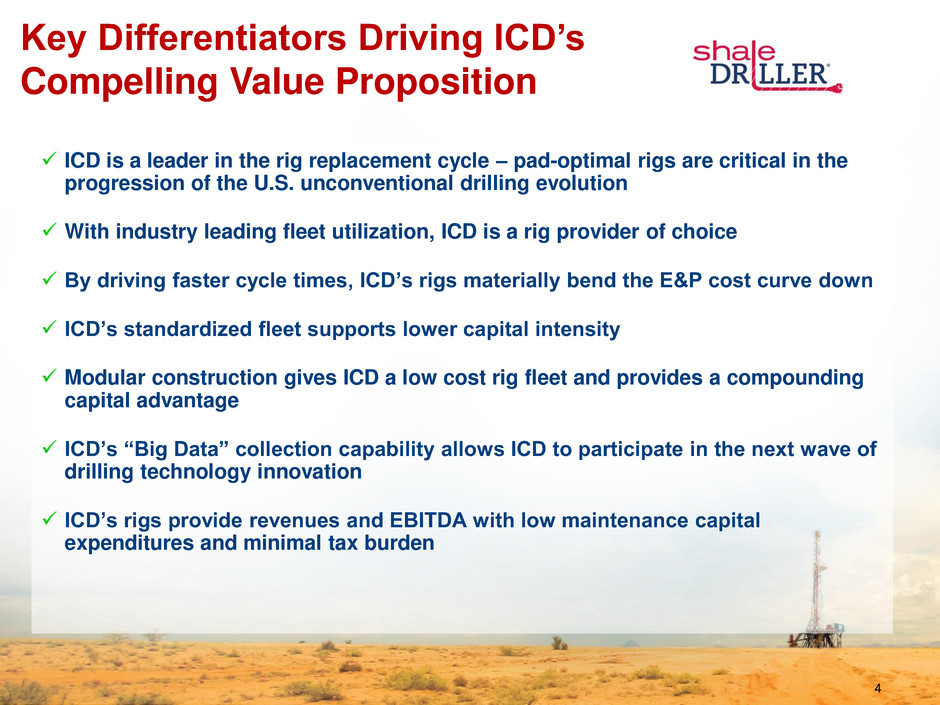
ICD is a leader in the rig replacement cycle – pad-optimal rigs are critical in the
progression of the U.S. unconventional drilling evolution
With industry leading fleet utilization, ICD is a rig provider of choice
By driving faster cycle times, ICD’s rigs materially bend the E&P cost curve down
ICD’s standardized fleet supports lower capital intensity
Modular construction gives ICD a low cost rig fleet and provides a compounding
capital advantage
ICD’s “Big Data” collection capability allows ICD to participate in the next wave of
drilling technology innovation
ICD’s rigs provide revenues and EBITDA with low maintenance capital
expenditures and minimal tax burden
Key Differentiators Driving ICD’s
Compelling Value Proposition
4
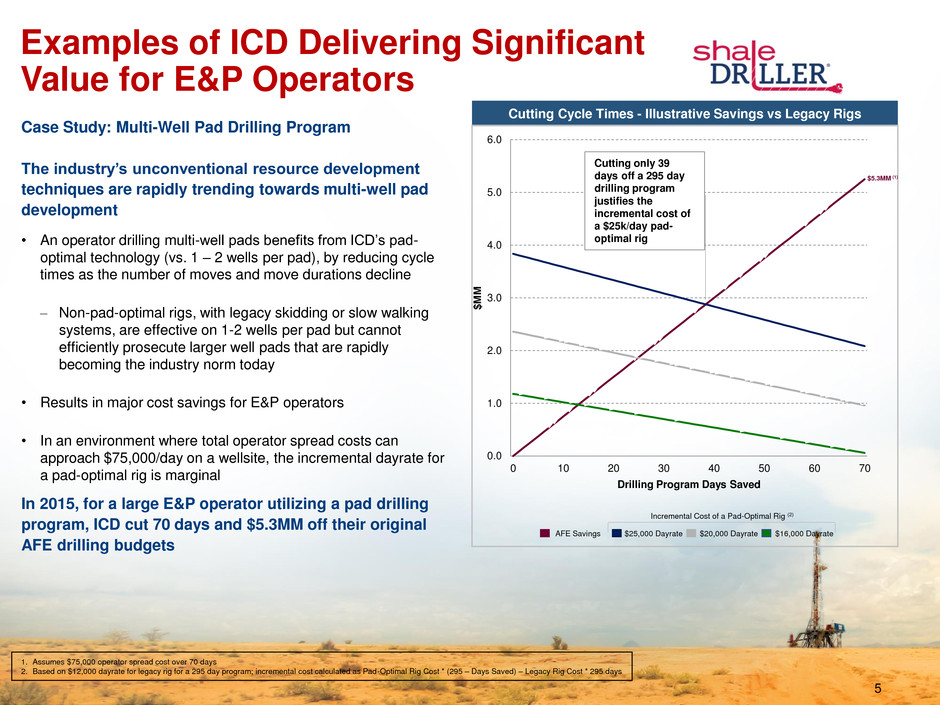
0.0
1.0
2.0
3.0
4.0
5.0
6.0
0 10 20 30 40 50 60 70
$
M
M
Drilling Program Days Saved
Cutting only 39
days off a 295 day
drilling program
justifies the
incremental cost of
a $25k/day pad-
optimal rig
$16,000 Dayrate$20,000 Dayrate$25,000 Dayrate
Incremental Cost of a Pad-Optimal Rig (2)
AFE Savings
Examples of ICD Delivering Significant
Value for E&P Operators
Cutting Cycle Times - Illustrative Savings vs Legacy Rigs
1. Assumes $75,000 operator spread cost over 70 days
2. Based on $12,000 dayrate for legacy rig for a 295 day program; incremental cost calculated as Pad-Optimal Rig Cost * (295 – Days Saved) – Legacy Rig Cost * 295 days
5
Case Study: Multi-Well Pad Drilling Program
The industry’s unconventional resource development
techniques are rapidly trending towards multi-well pad
development
• An operator drilling multi-well pads benefits from ICD’s pad-
optimal technology (vs. 1 – 2 wells per pad), by reducing cycle
times as the number of moves and move durations decline
‒ Non-pad-optimal rigs, with legacy skidding or slow walking
systems, are effective on 1-2 wells per pad but cannot
efficiently prosecute larger well pads that are rapidly
becoming the industry norm today
• Results in major cost savings for E&P operators
• In an environment where total operator spread costs can
approach $75,000/day on a wellsite, the incremental dayrate for
a pad-optimal rig is marginal
In 2015, for a large E&P operator utilizing a pad drilling
program, ICD cut 70 days and $5.3MM off their original
AFE drilling budgets
$5.3MM (1)
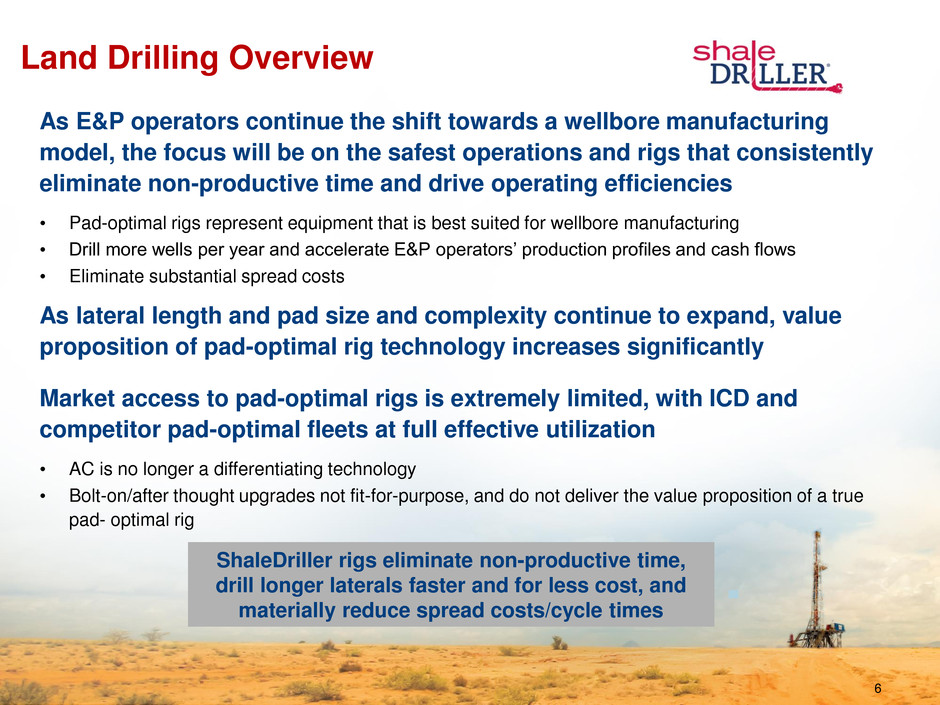
Land Drilling Overview
6
As E&P operators continue the shift towards a wellbore manufacturing
model, the focus will be on the safest operations and rigs that consistently
eliminate non-productive time and drive operating efficiencies
• Pad-optimal rigs represent equipment that is best suited for wellbore manufacturing
• Drill more wells per year and accelerate E&P operators’ production profiles and cash flows
• Eliminate substantial spread costs
As lateral length and pad size and complexity continue to expand, value
proposition of pad-optimal rig technology increases significantly
Market access to pad-optimal rigs is extremely limited, with ICD and
competitor pad-optimal fleets at full effective utilization
• AC is no longer a differentiating technology
• Bolt-on/after thought upgrades not fit-for-purpose, and do not deliver the value proposition of a true
pad- optimal rig
ShaleDriller rigs eliminate non-productive time,
drill longer laterals faster and for less cost, and
materially reduce spread costs/cycle times
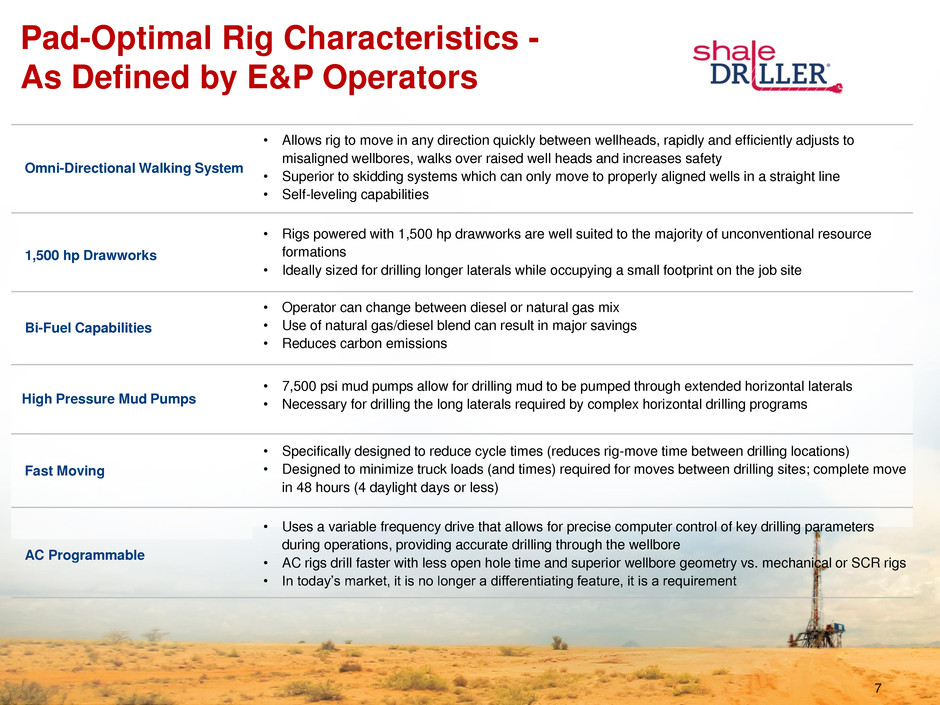
High Pressure Mud Pumps
Pad-Optimal Rig Characteristics -
As Defined by E&P Operators
Omni-Directional Walking System
• Allows rig to move in any direction quickly between wellheads, rapidly and efficiently adjusts to
misaligned wellbores, walks over raised well heads and increases safety
• Superior to skidding systems which can only move to properly aligned wells in a straight line
• Self-leveling capabilities
1,500 hp Drawworks
• Rigs powered with 1,500 hp drawworks are well suited to the majority of unconventional resource
formations
• Ideally sized for drilling longer laterals while occupying a small footprint on the job site
Bi-Fuel Capabilities
• Operator can change between diesel or natural gas mix
• Use of natural gas/diesel blend can result in major savings
• Reduces carbon emissions
• 7,500 psi mud pumps allow for drilling mud to be pumped through extended horizontal laterals
• Necessary for drilling the long laterals required by complex horizontal drilling programs
7
Fast Moving
• Specifically designed to reduce cycle times (reduces rig-move time between drilling locations)
• Designed to minimize truck loads (and times) required for moves between drilling sites; complete move
in 48 hours (4 daylight days or less)
AC Programmable
• Uses a variable frequency drive that allows for precise computer control of key drilling parameters
during operations, providing accurate drilling through the wellbore
• AC rigs drill faster with less open hole time and superior wellbore geometry vs. mechanical or SCR rigs
• In today’s market, it is no longer a differentiating feature, it is a requirement
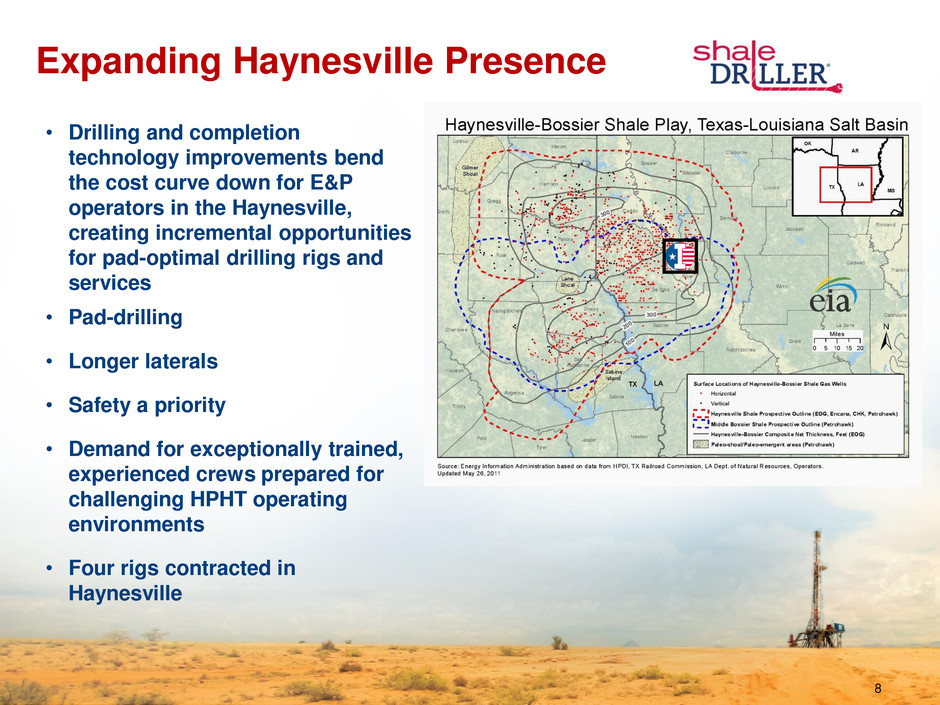
Expanding Haynesville Presence
• Drilling and completion
technology improvements bend
the cost curve down for E&P
operators in the Haynesville,
creating incremental opportunities
for pad-optimal drilling rigs and
services
• Pad-drilling
• Longer laterals
• Safety a priority
• Demand for exceptionally trained,
experienced crews prepared for
challenging HPHT operating
environments
• Four rigs contracted in
Haynesville
8

Current or past ICD customers
High-Quality Customer Base
ICD Customers Include Some of the Highest Quality,
Most Active Players in the Permian Basin
ICD has established a deep and high-quality customer base
composed of some of the most active players in the Permian
Basin
• Expanding contractual backlog of term contracts:
– Proforma Backlog at 12/31/16: $75 million(1), including six term
contracts signed since year-end 2016
– Subsequent to February 28, 2017, ICD signed an additional term
contract relating to a rig operating in the spot market
• ICD’s fleet standardization provides several benefits for customers
including consistent branding, predictability in performance and quick
understanding of the rig’s capabilities
• ICD is focused on strategically expanding its customer base
– Target markets are Texas and the contiguous states
– Target customers with significant investments and willingness to drill
through industry cycles
– Target operators who value safety and efficient operations
– Focus on customers willing to enter into long-term contractual
relationships
9
ICD Customer Base Breakdown (2)
1. As of February 28, 2017, includes contracts signed subsequent to 12/31/16. Excludes term contract signed subsequent to February 28, 2017. Backlog does not include potential reductions in rates for periods in which the rig is
moving, on standby or incurring maintenance and repair time in excess of contractually allowed downtime. In addition, ICD currently expects that at least one rig under term contract will realize revenue on a standby-without-crew basis
during Q1’17, which preserves expected cash margins from the contract but reduces overall top-line revenue included in backlog. To the extent that rigs under term contracts operate on a standby or standby-without-crew basis, top
line revenues will be less than reported backlog from term contracts.
2.. Represents percentage of rigs contracted with public customers and private customers..
Source: Wall Street Consensus Estimates and Company Guidance as of March 1, 2017
69%
31%
Public Private

ICD Positioned for Growth
• Final rig conversion underway with
scheduled completion late 2Q’17 / early
3Q’17
• ICD in conversations with customers
regarding delivery of additional rigs
(two newbuilds) for which ICD has
already made substantial investments
• Recently signed term contracts expand
12/31/16 backlog on a proforma basis
to $75 million(1)
• Staggered term contract expiration
matrix provides foundational support
to fund additional newbuilds under
credit facility, while maintaining upside
to capture further dayrate improvement
driven by full effective utilization of pad
optimal rigs across U.S. land industry
0
1
2
3
4
5
Q1'17 Q2'17 Q3'17 Q4'17 Q1'18
Current 200 Series Fleet
ICD rigs available to capture
additional dayrate in an improving
market environment (2)
(1) As of February 28, 2017. Excludes term contract signed subsequent to February 28, 2017.
(2) Number of contracts expiring during applicable quarter for rigs within ICD’s current marketable fleet of 13 ShaleDriller rigs. Includes term contract signed subsequent to February 28, 2017 relating to rig
previously operating in spot market. Excludes three additional rigs (final rig conversion, two newbuilds) ICD is currently discussing with customers. Delivery of such additional rigs, and the timing of delivery of
such rigs, subject to continuing improvement in market conditions. See forward looking statements..
(2)
10

Financial Flexibility
• ICD backlog expanding, with contract tenors
and dayrates increasing for all contracts signed
since 12/31/16
• ICD revised capital budget for 2017 is
approximately $21.0 million and includes costs
associated with final three 7,500 psi upgrades,
maintenance capital expenditures, additions to
capital spare inventories and other equipment,
and completion of final rig conversion
• ICD has already made significant investment
towards its next two newbuild ShaleDriller®
rigs - following completion of these projects,
ICD fleet would be comprised of sixteen 200
Series ShaleDriller® rigs
• ICD is ideally positioned to complete the next
two planned newbuild projects while still
maintaining a strong liquidity position
• ICD in preferential tax position
11
Financial Flexibility and Liquidity
$MM
Cash @ 12/31/16 $7.1
Plus: Revolving Credit Facility Capacity @ 12/31/16 85.0
Less: Outstanding Borrowings @ 12/31/16 (25.8)
Total Liquidity $66.3
Less: 2017 capex budget(1) 21.0
2017 planned asset sale(2) (3.9)
Potential incremental growth capex(3) 22.0
Total Liquidity Adjusted (4) $27.2
Adjusted Net Debt / LTM Adj. EBITDA(4) 3.5x
Adjusted Total Debt / Total Capitalization(4) 20.1%
(1) As of March 22, 2017.
(2) Estimated fair value, less selling costs, of assets held for sale as of December 31, 2016.
(3) Estimated incremental investment of next two newbuild rigs. Actual costs may differ based upon final rig configuration and contractual requirements.
(4) Assumes all budgeted capex, planned asset sales and potential growth capex occurred 12/31/16, and funded through additional borrowings under existing credit facility. Excludes debt associated with vehicle capital
leases. See non-GAAP financial measures for calculation of last 12 months adjusted EBITDA.
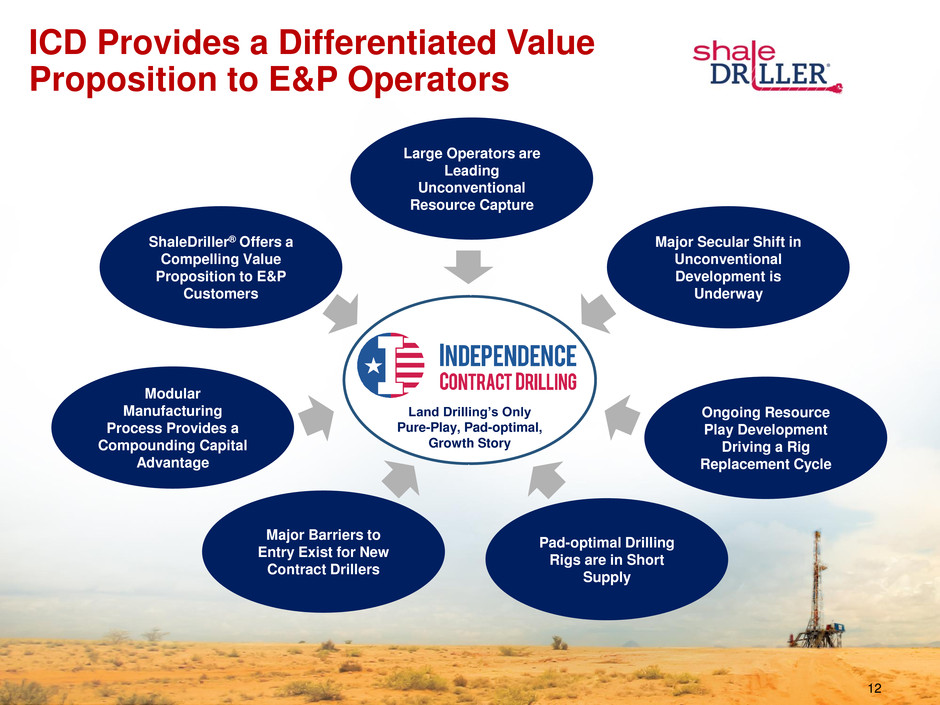
Land Drilling’s Only
Pure-Play, Pad-optimal,
Growth Story
Large Operators are
Leading
Unconventional
Resource Capture
Major Secular Shift in
Unconventional
Development is
Underway
Ongoing Resource
Play Development
Driving a Rig
Replacement Cycle
Pad-optimal Drilling
Rigs are in Short
Supply
Major Barriers to
Entry Exist for New
Contract Drillers
Modular
Manufacturing
Process Provides a
Compounding Capital
Advantage
ShaleDriller® Offers a
Compelling Value
Proposition to E&P
Customers
ICD Provides a Differentiated Value
Proposition to E&P Operators
12
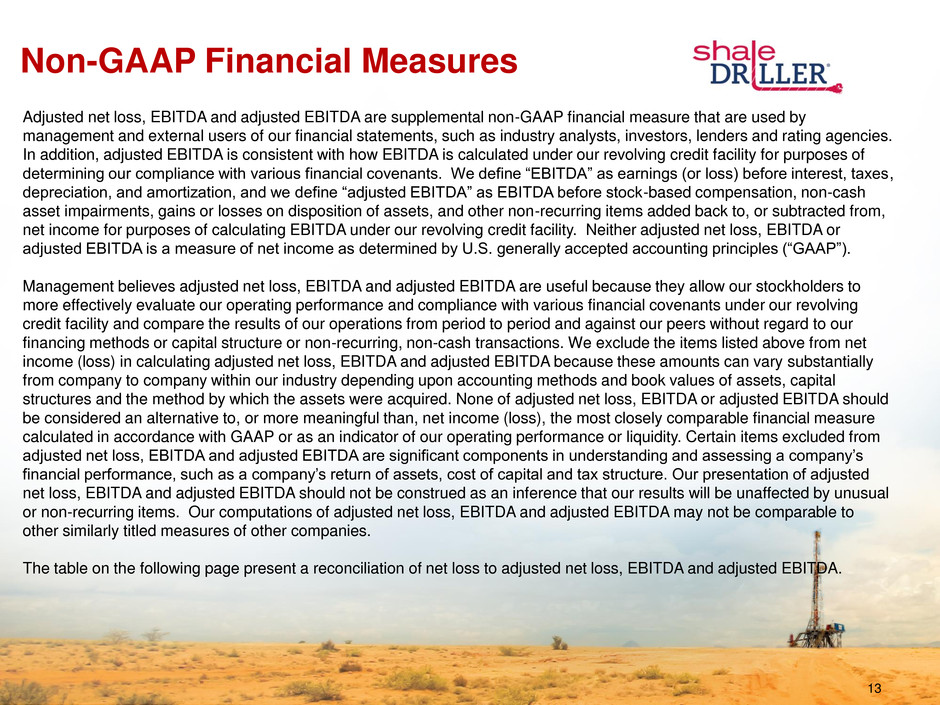
Non-GAAP Financial Measures
13
Adjusted net loss, EBITDA and adjusted EBITDA are supplemental non-GAAP financial measure that are used by
management and external users of our financial statements, such as industry analysts, investors, lenders and rating agencies.
In addition, adjusted EBITDA is consistent with how EBITDA is calculated under our revolving credit facility for purposes of
determining our compliance with various financial covenants. We define “EBITDA” as earnings (or loss) before interest, taxes,
depreciation, and amortization, and we define “adjusted EBITDA” as EBITDA before stock-based compensation, non-cash
asset impairments, gains or losses on disposition of assets, and other non-recurring items added back to, or subtracted from,
net income for purposes of calculating EBITDA under our revolving credit facility. Neither adjusted net loss, EBITDA or
adjusted EBITDA is a measure of net income as determined by U.S. generally accepted accounting principles (“GAAP”).
Management believes adjusted net loss, EBITDA and adjusted EBITDA are useful because they allow our stockholders to
more effectively evaluate our operating performance and compliance with various financial covenants under our revolving
credit facility and compare the results of our operations from period to period and against our peers without regard to our
financing methods or capital structure or non-recurring, non-cash transactions. We exclude the items listed above from net
income (loss) in calculating adjusted net loss, EBITDA and adjusted EBITDA because these amounts can vary substantially
from company to company within our industry depending upon accounting methods and book values of assets, capital
structures and the method by which the assets were acquired. None of adjusted net loss, EBITDA or adjusted EBITDA should
be considered an alternative to, or more meaningful than, net income (loss), the most closely comparable financial measure
calculated in accordance with GAAP or as an indicator of our operating performance or liquidity. Certain items excluded from
adjusted net loss, EBITDA and adjusted EBITDA are significant components in understanding and assessing a company’s
financial performance, such as a company’s return of assets, cost of capital and tax structure. Our presentation of adjusted
net loss, EBITDA and adjusted EBITDA should not be construed as an inference that our results will be unaffected by unusual
or non-recurring items. Our computations of adjusted net loss, EBITDA and adjusted EBITDA may not be comparable to
other similarly titled measures of other companies.
The table on the following page present a reconciliation of net loss to adjusted net loss, EBITDA and adjusted EBITDA.
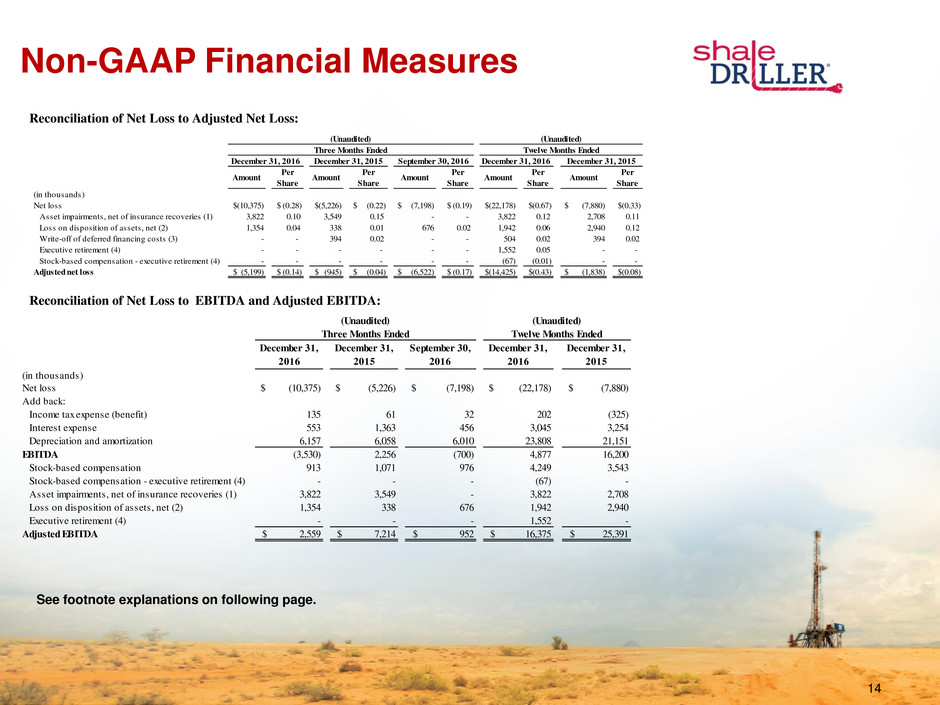
Non-GAAP Financial Measures
14
Reconciliation of Net Loss to Adjusted Net Loss:
Amount
Per
Share
Amount
Per
Share
Amount
Per
Share
Amount
Per
Share
Amount
Per
Share
(in thousands)
Net loss $(10,375) $ (0.28) $(5,226) $ (0.22) $ (7,198) $ (0.19) $(22,178) $(0.67) $ (7,880) $(0.33)
A et impairments, net of insurance recoveries (1) 3,822 0.10 3,549 0.15 - - 3,822 0.12 2,708 0.11
Loss on disposition of assets, net (2) 1,354 0.04 338 0.01 676 0.02 1,942 0.06 2,940 0.12
Write-off of deferred financing costs (3) - - 394 0.02 - - 504 0.02 394 0.02
Executive retirement (4) - - - - - - 1,552 0.05 - -
Stock-based compensation - executive retirement (4) - - - - - - (67) (0.01) - -
Adjusted net loss $ (5,199) $ (0.14) $ (945) $ (0.04) $ (6,522) $ (0.17) $(14,425) $(0.43) $ (1,838) $(0.08)
Twelve Months Ended
(Unaudited)
Three Months Ended
(Unaudited)
December 31, 2016 December 31, 2015 September 30, 2016 December 31, 2016 December 31, 2015
Reconciliation of Net Loss to EBITDA and Adjusted EBITDA:
December 31,
2016
December 31,
2015
S ptember 30,
2016
December 31,
2 16
December 31,
2015
(in thousands)
et loss $ (10,375) $ (5,226) $ (7,198) $ (22,178) $ (7,880)
Add back:
Income tax expense (benefit) 135 61 32 202 (325)
Inter st expense 553 1,363 456 3,045 3,254
Depreci tion and amortization 6,157 6,058 6,010 23,808 21,151
EBITDA (3,530) 2,2 6 (700) 4,8 7 16,20
S ck-based compensation 913 1,071 976 4,249 3,543
Stock-based compensation - executive retirement (4) - - - (67) -
Asset impairments, net of insurance recoveries (1) 3,822 3,549 - 3,822 2,708
Loss on disposition of assets, net (2) 1,354 338 676 1,942 2,940
Executive retirement (4) - - - 1,552 -
Adjusted EBITDA $ 2,559 $ 7,214 $ 952 $ 16,375 $ 25,391
(Unaudited)
Twelve Months EndedThree Months Ended
(Unaudited)
See footnote explanations on following page.

Non-GAAP Financial Measures
15
(1) In the fourth quarter of 2016, we recorded a $3.8 million, or $0.10 per share, non-cash write-down of assets held for sale to reflect their current fair value
less estimated selling costs. In the fourth quarter of 2015, we recorded a $3.6 million, or $0.15 per share, impairment associated with our remaining non-
walking 100 Series rig that will not be converted to 200 series status until market conditions improve. For the full year 2016, we recorded a $3.8 million, or
$0.12 per share, non-cash impairment of assets held for sale to reflect their current market value less estimated selling costs and for the full year 2015 we
recorded a $2.7 million, or $0.11 per share, impairment associated with our remaining non-walking 100 Series rig mentioned above and the impairment of a
damaged driller’s cabin, net of insurance recoveries.
(2) In the fourth quarter of 2016, we recorded a loss on disposition of assets of $1.4 million, or $0.04 per share, primarily due to non-cash disposal of
equipment in connection with the upgrade to 7,500 psi mud systems. In the fourth quarter of 2015, we recorded a loss on disposition of assets of $0.3
million, or $0.01 per share, associated with the disposition of assets largely attributable to a rig conversion that was completed during the first quarter of
2016, and in the third quarter of 2016 we recorded a loss on disposition of assets of $0.7 million, or $0.02 per share, primarily due to non-cash disposal of
equipment in connection with the upgrade to 7,500 psi mud systems. For the full year 2016, we recorded a loss on disposition of assets of $1.9 million, or
$0.06 per share, primarily due to non-cash disposal of equipment in connection with the upgrade to 7,500 psi mud systems and for the full year 2015 we
recorded $2.9 million, or $0.12 per share, associated with the disposition of assets largely attributable to the Company’s rig conversion that was completed
during the first quarter of 2016.
(3) For the full year 2016, we recorded $0.5 million, or $0.02 per share, related to the amortization of deferred financing costs in connection with a reduction of
commitments under the Company’s revolving credit facility in April 2016. In the fourth quarter of 2015 and for the full year of 2015, we recorded $0.4
million, or $0.02 per share, related to the amortization of deferred financing costs in connection with a reduction of commitments under the Company’s
revolving credit facility in October 2015.
(4) For the full year 2016, we recorded $1.5 million, or $0.04 per share, of retirement benefits associated with the departure of an executive officer.
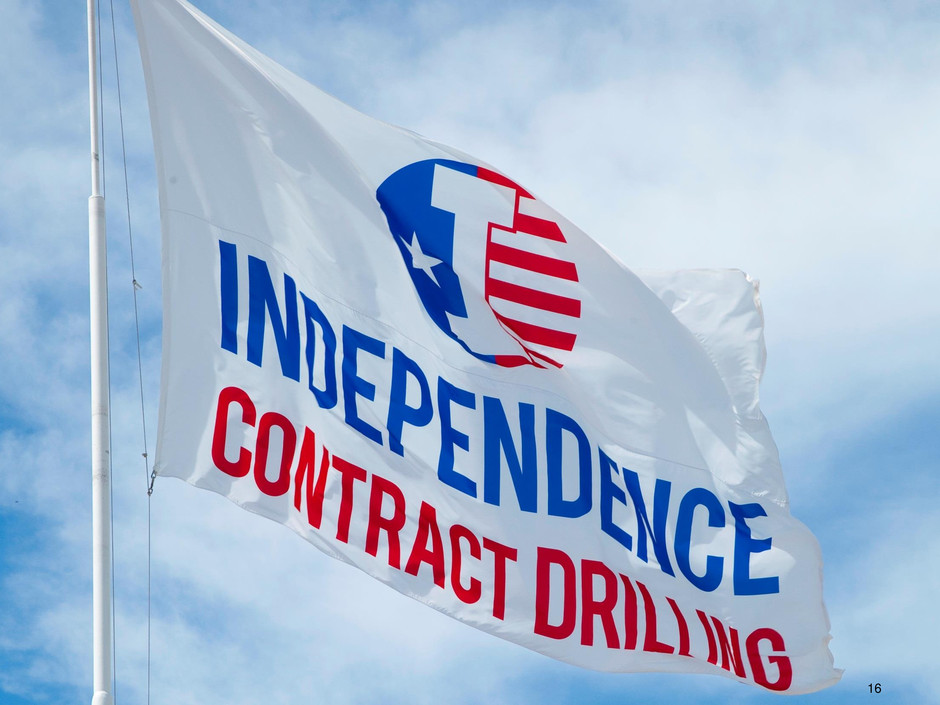
16
